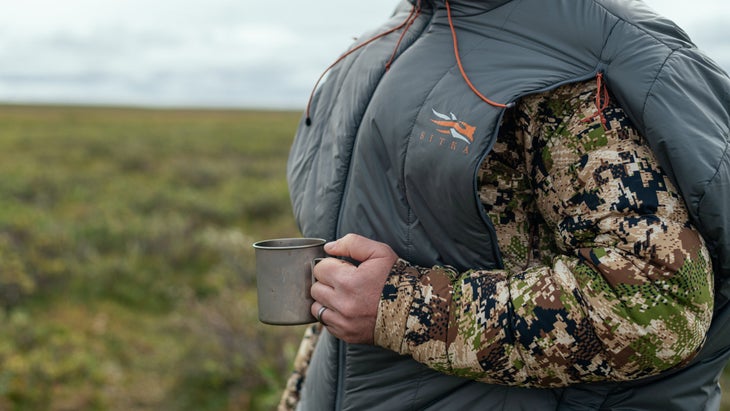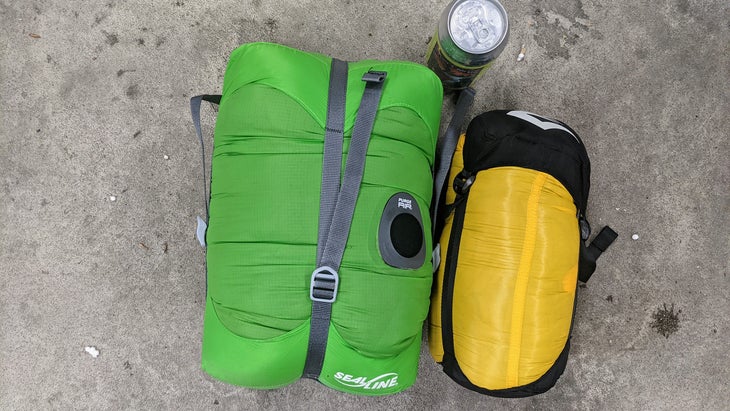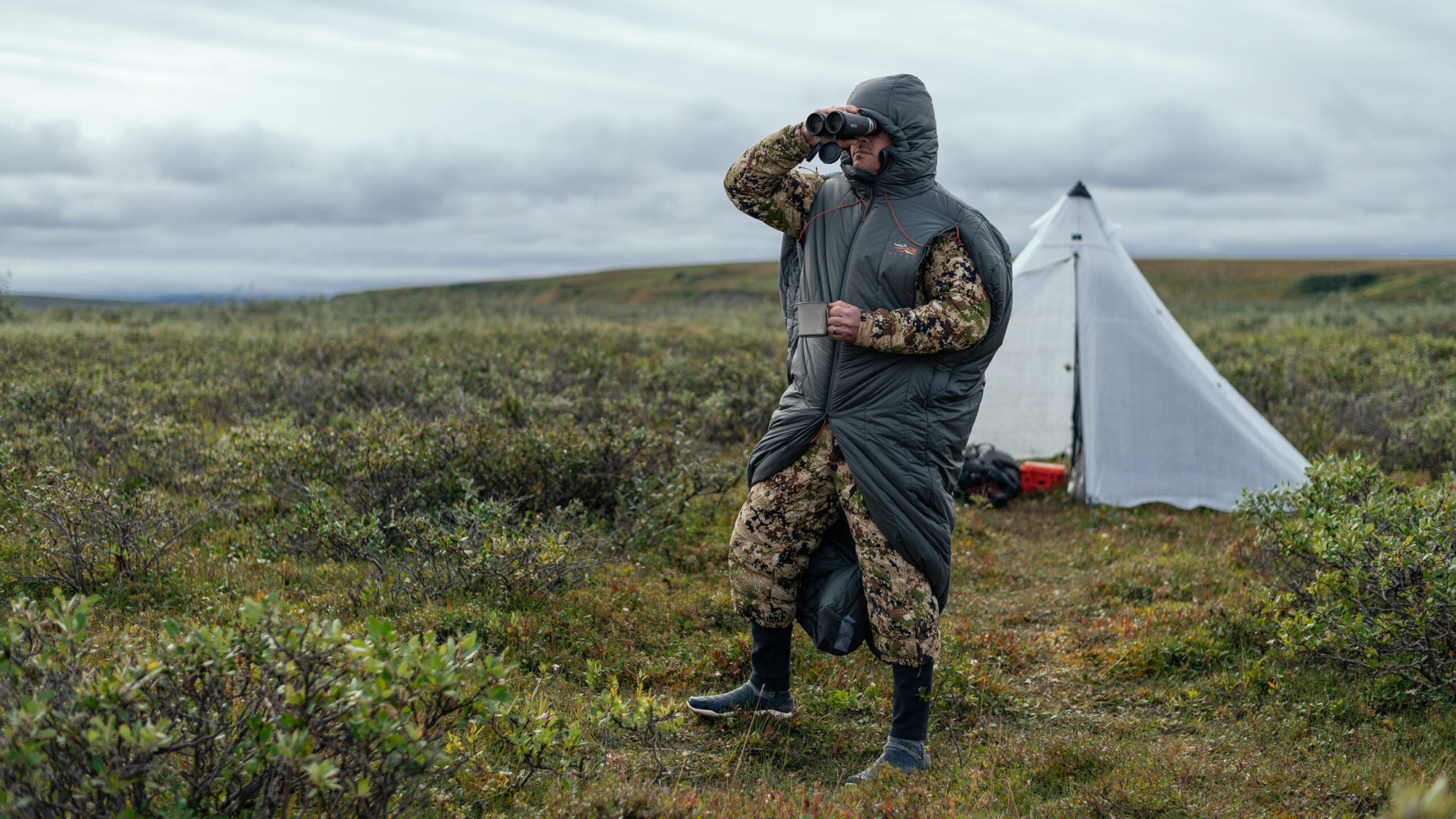When John Barklow designs a new product, I get excited. The big-game product manager for Bozeman, Montana-based hunting brand Sitka began his career as a diver in the Navy, before moving on to teach SEALs outdoor survival techniques. Then in the early 2000s, during the War on Terror, Barklow started to design clothing systems for Special Operations Forces soldiers.��His big innovation during that time was acknowledging that, in extreme weather outdoors, it’s often impossible to stay dry, so clothing made for those conditions needs to dry as fast as possible.��
If you’ve worn highly breathable mid-layers like Polartec Alpha, or taken advantage of a clothing system that combines synthetic base layers and mid-layers with a soft shell, you’ve likely benefited from Barklow’s expertise. But the designer had yet to turn his attention to sleeping bags.��
Barklow brought two major innovations to the new ($400). It’s the first sleeping bag to use Primaloft’s newest synthetic insulation, and this is the only a time a designer has put a bag through International Organization for Standardization (ISO) test procedures, along with specific layers of clothing. That gives the Aerolite two major advantages. Even when fully wetted out, and fully compressed under your body weight, its insulation is still able to keep you warm; and Barklow can prescribe a specific set of layers that let you to take the bag well below its temperature rating, while still sleeping comfortably.��
Together, those innovations enable the Aerolite to work outside of the limited role traditionally filled by sleeping bags. Rather than simply keeping you warm while you sleep, the Aerolite also serves as your outer clothing layer to help you stay cozy during static activity, and it works to dry out your other layers while you’re wearing it.��
“The sleeping bag is the final part of your clothing system,” says Barklow. “It’s your last line of defense against the cold; it’s your armor from the elements.”
The Aerolite employs the new Primaloft Gold Insulation with Cross Core. Like other synthetic insulations, Primaloft Gold’s loft isn’t compromised by moisture, which means it remains warm when wet. The synthetic fiber insulation comes close to the weight and packability of down, and its fibers contain , a very porous, very light material that’s one of the best insulators ever created. So equipped, the fibers that make up that insulation are able to trap warm air internally, meaning that even when the material is fully compressed, it still insulates.��
“The insulation in the bag excels in wet conditions because of the Aerogel trapped within each fiber,” says Barklow. “The physical loft of the insulation will be compressed by the user in certain areas, but the air trapped by the mechanical design of the Aerogel will remain and provide warmth.”

To determine temperature ratings—comfort, extreme, and limit—makers of sleeping bags put their products through the�� test procedure. The test dictates a sleeping pad with an R-Value of around 4.0, and equips the test mannequin with a set of light base layers. Consumers can then cross-shop bags based on like-for-like data.
In the ISO 23537, the Aerolite achieves a comfort rating of 38 degrees, a limit rating of 28 degrees, and an extreme rating of zero degrees. Barklow also ran the bag through that same test in the same lab with different clothing layers. Because the official ISO test procedure only allows for those light base layers, he emphasizes that his prescription for layering up for specific colder temperatures does not carry official ISO certification.��
To endow yourself with equivalent insulation to a 20-degree comfort rating, Barklow recommends using lightweight base layers, a Polartec Alpha mid-layer, a lightweight puffy jacket, a soft-shell pant, an insulated beanie, light fleece gloves, and insulated booties. To take that down to ten degrees, the base layers need to go up to mid-weight items, the puffy needs to get thicker, and equivalent puffy pants need to be added. are his designs for Sitka. You could substitute those for similar picks from other brands, just like you can always layer up inside any sleeping bag, but achieving equivalent performance will rely on your own trial and error.
The Aerolite’s limited temperature rating, together with these layering guidelines, illustrates the role the bag is intended to fill. It’s specifically designed to be used along with your clothing, so you can carry a smaller, lighter bag and get more out of the rest of that clothing.��
“A technical clothing system should work for you 24 hours a day and provide supplemental insulation when sleeping,” says Barklow.��
By equipping the Aerolite with zip-open arm holes, a close-fitting, jacket-style hood, and a two-way zipper that opens all the way to the foot box, along with a hook that can tuck that foot box up and out of the way, Barklow’s intention is for the bag to replace a hi-loft parka in your load out.��Wear the bag over your other layers, not only to sleep, but also while you’re hanging around camp. Light precipitation is shed by the durable water repellant coating on the beefy 20-denier face fabric, and it doesn’t seem to impact the bag’s performance if some of that moisture finds its way inside the insulation.��
It’ll also work to dry out your layers during the night, whether they’re damp from sweat or completely soaked by rain. Like the rest of Sitka’s clothing systems, the bag is designed to take advantage of the heat generated by your body to keep moisture moving outwards, even in the worst conditions. Inside multiple layers of shells and insulation, the heat your body generates creates a build up of pressure. Inside that system, that heat dries each subsequent layer and keeps pushing moisture outwards��until every component is dry. Sitka specifically designs its various layers to facilitate this process.
“I’ve gotten into the bag completely wet and dried out almost completely by morning—eight hours,” Barklow tells me. He and other testers at Sitka have been testing prototypes of the Aerolite for the last two years, leading up to its release in July.��

I just got back from using the Aerolite on a seven-night trip above the Arctic Circle, on the Alaskan tundra. The area is basically an enormous, soaking wet sponge, and it rained continuously throughout the trip, with temperatures ranging between the mid-twenties and high-thirties. There, equipped with a 5.7 R-value pad and Barklow’s recommended clothing system for a 20-degree comfort rating, I was warm every night of the trip. Even though I got into the bag late each evening with damp clothes, and often wet socks, I was never drier than when I woke up each morning.��
However, one thing the Aerolite is not, is warm on its own. At least not in sub-40-degree temperatures. Without a new bag to test, I would typically have packed a traditional down mummy bag with a 15- or zero-degree comfort rating. Crawling into that at night, I could have shed all my layers, and still been warmer than I was all layered up in the Aerolite. But, I could not have achieved that warmth as easily. Because even treated down loses its loft when it gets wet (waterproof treatments may enable it to dry faster), using a down-insulated sleeping bag in a wet environment dictates an exceptionally careful approach in which you must go to great lengths to protect the bag from any and all moisture. You have to be careful to pack and transport the sleeping bag inside a dry bag, set it up and allow it to loft well before bedtime, and most importantly, you can’t get anything wet, or even damp, anywhere near it. That typically means carrying an extra set of base layers, a pair of socks, and warm hat, just to wear when you sleep. An accident like submerging a down sleeping bag in a stream, or allowing rain to leak into your tent, could spell disaster. None of those downsides apply whatsoever to the Aerolite. It’s as foolproof as a sleeping bag can be, so long as you’re prepared to layer up when you sleep.
Barklow acknowledges that the Aerolite won’t be for everyone. “Folks who are chasing every ounce, or those who don’t recreate in dynamic climates, may choose a different bag or insulation,” he says. If you just want a sleeping bag you can crawl into and feel warm with little to no additional layers or effort, Sitka’s new bag is not for you. But, people going outdoors with a mission, who don’t want weather to slow them down, may find the Aerolite uniquely capable. “This bag allows the user to stay focused on why they’re out in nature and not worry so much about the weather.”


